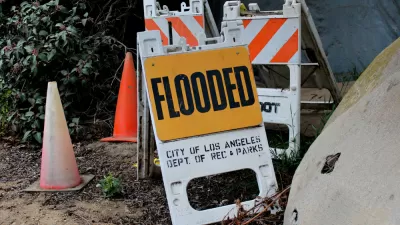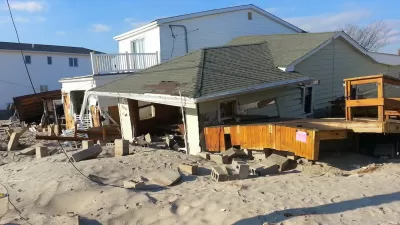Recently revealed estimates put far more people in the region at risk for catastrophic flooding than previously thought.

The Los Angeles County Board of Supervisors wants to know how to shore up the region’s flood control infrastructure as experts predict “an increase in epic downpours” that could pose significant flood risk to many L.A. communities. Louis Sahagún reports on the story for the Los Angeles Times.
The supervisors are calling for a report from the Department of Public Works (DPW) detailing the state of existing infrastructure and plans for improving it. The motion comes in response to a recent study that highlighted the disproportionate risk faced by low-income communities of color. “The study’s unprecedented combination of high-resolution flood modeling and socioeconomic data indicates that major floods would occur between the Dominguez Channel on the west and the Los Angeles River on the east,” Sahagún writes, noting that the analysis put roughly 874,000 people and as much as $108 billion in property at risk for catastrophic flooding.
“Until recently, it was thought that a flood event of that magnitude was likely to occur every 1,000 to 10,000 years. New research, however, suggests that the chances of seeing another one of that scale over the next 40 years are about 50/50.” This makes the urgency of upgrading flood control and mitigation infrastructure more severe than previously thought. According to Mark Pestrella, director and chief engineer of the Los Angeles County Flood Control District, “The Board’s action today aligns with the county’s sustainable plan to make infrastructure improvements that reduce flood risk, increase local water supplies through stormwater capture and groundwater recharge, and improve water quality across the county.”
FULL STORY: Los Angeles County seeks flood control improvements in face of climate change

Planetizen Federal Action Tracker
A weekly monitor of how Trump’s orders and actions are impacting planners and planning in America.

Trump Administration Could Effectively End Housing Voucher Program
Federal officials are eyeing major cuts to the Section 8 program that helps millions of low-income households pay rent.

The 120 Year Old Tiny Home Villages That Sheltered San Francisco’s Earthquake Refugees
More than a century ago, San Francisco mobilized to house thousands of residents displaced by the 1906 earthquake. Could their strategy offer a model for the present?

Washington State Legislature Passes Parking Reform Bill
A bill that would limit parking requirements for new developments is headed to the governor’s desk.

Missouri Law Would Ban Protections for Housing Voucher Users
A state law seeks to overturn source-of-income discrimination bans passed by several Missouri cities.

Op-Ed: Looking for Efficiency? Fund Intercity Buses
Much less expensive than rail, intercity buses serve millions of Americans every year, but public subsidies are lacking.
Urban Design for Planners 1: Software Tools
This six-course series explores essential urban design concepts using open source software and equips planners with the tools they need to participate fully in the urban design process.
Planning for Universal Design
Learn the tools for implementing Universal Design in planning regulations.
Ada County Highway District
Clanton & Associates, Inc.
Jessamine County Fiscal Court
Institute for Housing and Urban Development Studies (IHS)
City of Grandview
Harvard GSD Executive Education
Toledo-Lucas County Plan Commissions
Salt Lake City
NYU Wagner Graduate School of Public Service





























